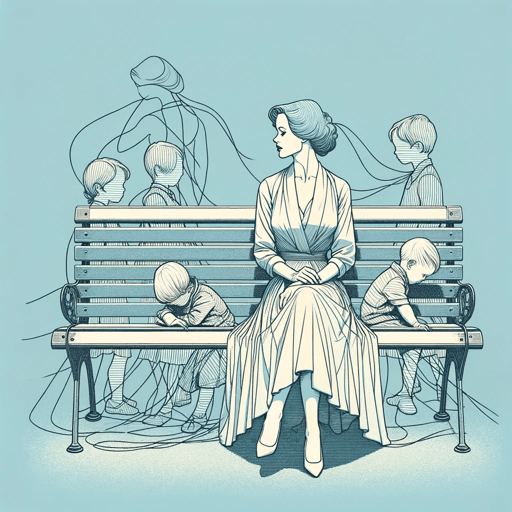19 pages • 38 minutes read
Gwen HarwoodIn The Park
Fiction | Poem | Adult | Published in 1961A modern alternative to SparkNotes and CliffsNotes, SuperSummary offers high-quality Study Guides with detailed chapter summaries and analysis of major themes, characters, and more.
Summary and Study Guide
Overview
“In the Park” is a 1961 lyric poem by Australian poet and librettist Gwen Harwood that is frequently anthologized. The poem considers the intimate feelings that women face regarding motherhood and marriage, topics not often directly addressed during the time in which Harwood composed the poem. "In the Park" also touches on Harwood's interest in music; her skeptical attitude toward sonnets is reflected in the poem's in the form, rhyme scheme, and word choices.
Poet Biography
Gwendoline Nessie Foster Harwood was born on June 8, 1920 in a suburb outside of Brisbane, Australia. Her grandmother brought poetry into Harwood's life. Her father, a secretary and a multi-instrumentalist, encouraged Harwood's interest in piano. After being an assistant piano instructor, Harwood became an organist for All Saints’ Anglican Church, where she met Reverend Peter Bennie, an intellectual mentor who introduced her to Lieutenant Thomas “Tony” Riddell, a kindred spirit in music and poetry. Harwood would later dedicate many of her poetry collections to Riddell.
At age 21, Harwood experimented with several career paths: She briefly entered a Franciscan convent and then taught music at St. Christopher’s Church of England School for Boys for five months. After WWII broke out, she became a clerk for the War Damage Commission, working there until 1945.
At age 24 in 1944, Harwood published her first poem in the Australian journal Meanjin. In 1945, she married linguist Bill Harwood, a lecturer at the University of Tasmania. Harwood immersed herself in the work of Austrian philosopher Ludwig Wittgenstein, who examined language and logic in relation to understanding the world. Her interest in his work had an impact on her poetry.
In the 1960s, Harwood began to publish more poems, including her first collection, Poems, in 1963. However, she found she could do so only under a male pseudonym, most notably “Walter Lehman,” the name first associated with her poem “In the Park.” Her frustration led to an act of protest. She sent two sonnets named for 18th century poet Alexander Pope's sonnets between Eloise and Abelard to the literary journal Bulletin. The sonnets contained acrostics (the initial letters of each poetic line spelled out messages): The first read "SO LONG BULLETIN" and the second, “F*** ALL EDITORS” as a jab at these incompetent gatekeepers. Harwood also used her male pseudonyms as fictional alter egos. For example, “Timothy Kline” was a clerk protesting the Vietnam War and other social injustices.
Throughout her lifetime, Harwood published five collections of poetry, and composed libretti for several composers—most notably, for Larry Sitsky, with whom she worked on the opera “The Fall of the House of Usher.” In total, she published 386 poems and 13 libretti. Harwood garnered awards and honors for her work, including the Robert Frost medallion in 1977, honorary doctorates from three universities in the 1980s and 1990s, and the appointment of president of the Fellowship of Australian Writers (Tasmanian Branch) in 1989.
In 1995, Harwood died from inoperable breast cancer, leaving behind her husband and four adult children, including poet and novelist John Harwood. The same year marked the inauguration of the Gwen Harwood Poetry Prize. Her poetry has become canonical, with students studying her work in accordance with the Victorian Certificate of Education and the New South Wales Board of Studies.
Poem Text
Harwood, Gwen. “In The Park.” 2008. Poem Hunter.
Summary
The poem's three stanzas offer a third-person description of a woman sitting in the park while her children hover around her. The first stanza addresses the woman’s unfashionable appearance, the rather draining and demanding complaints of two of the children, and the more creative behavior of the third. The final line of the first stanza introduces a new character: Someone that the woman now beset by maternal concerns “loved once” (Line 4).
In the second stanza, the woman exchanges seemingly casual pleasantries with this man. Below this surface inconsequential banter, the woman can detect the man's judgmental relief at having escaped this domestic imprisonment.
The third and final stanza moves into specifics of their conversation, including “children’s names and birthdays” (Line 10). The woman, as befits social expectations of what mothers should feel, tells the man how great it is to have children. Then, when he walks away with a smile, she speaks the truth “to the wind” (Line 14), revealing that becoming a mother has been a destructive process in which the woman has been totally subsumed to her duties: "They have eaten me alive" (Line 15).

